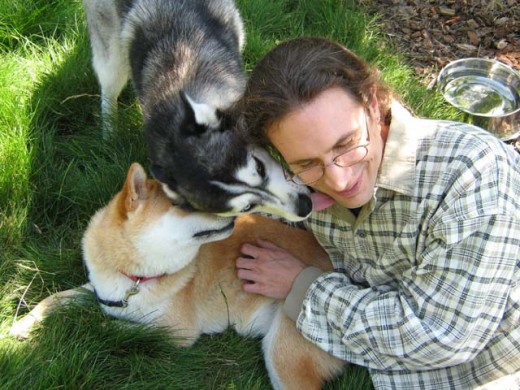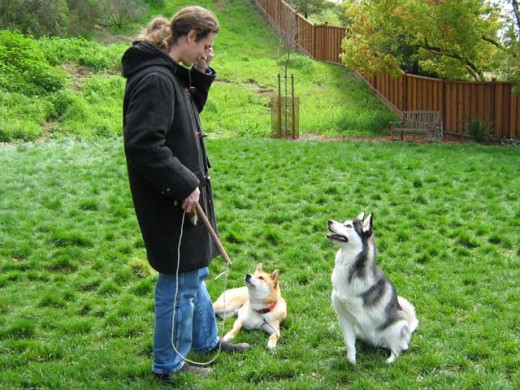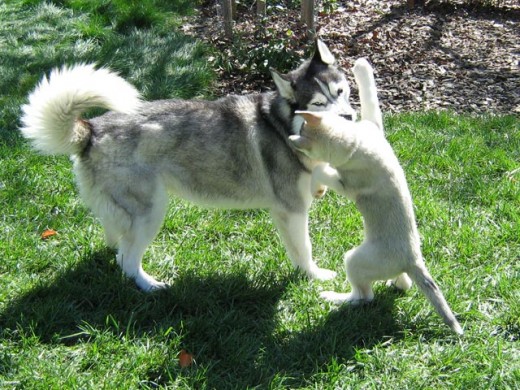Reward dog training allows us to control our dog’s behaviors by controlling his most desired resources, including food, affection, toys, freedom, play, access to people, access to other dogs, and much more.
For reward training to work well, we must first identify what our dog likes. Then,
- We encourage desired behaviors by giving him a reward (positive reinforcement), or
- We discourage undesired behaviors by taking away a reward (negative punishment).
Some common myths about reward dog training –
- Reward dog training does not work with dominant, stubborn, or aggressive dogs.
My Shiba Inu is all of those things and reward methods worked much better on him than aversive dog training. Aversive methods just made him more aggressive. - Using food in dog training is bribery, because the dog should be doing the command for us.
Dogs, like us, are motivated by a variety of things. Some of them are more food motivated, while others are more people motivated. We should use the rewards that are appropriate, based on the temperament and preferences of our dog.
Note that in aversive dog training, the dog is not doing commands just for us either, but rather to avoid the aversive stimulus (e.g. pain). - Reward dog training does not show my dog that I am the boss or pack leader.
The truth is, reward methods allows us to become a better pack leader than aversive methods. In fact, alpha wolves primarily control their members by controlling the pack’s resources – which is basically reward dog training.

Reward Dog Training – Good 1

Reward Dog Training
Helps to build a relationship based on trust.
One of the biggest advantage of reward dog training, is that there is little danger of losing our dog’s trust, even if we make some training mistakes. If we do not do dog obedience training for a living, we may not always execute our techniques perfectly, or even close to perfectly.
Some mistakes will be made, while we learn how to effectively train our dog.
If we are using reward dog training, a mistake may get our dog a bit confused, as to why he is receiving a reward. A string of continuous mistakes, may inadvertently encourage unwanted behaviors, such as jumping, but that is about as bad as it gets.
Aversive dog training, on the other hand, can very easily cause loss of trust. It may even lead to aggression.
In fact this University of Pennsylvania 2009 study shows that at least 25% of the dogs that are trained with confrontational methods, exhibit aggression during training.
“This study highlights the risk of dominance-based training, which has been made popular by TV, books and punishment-based training advocates,”Herron said. “These techniques are fear-eliciting and may lead to owner-directed aggression.”

Reward Dog Training – Good 2
Will not damage our dog either physically or mentally.
With reward dog training, the worst that happens to our dog is the removal of a reward. He may look at us cross-eyed, but he will not go home with a hurt trachea or other bodily harm. In contrast, this type of physical damage can occur, when certain aversive methods are not implemented properly.
Note that prolonged use of choke collars may cause harm to our dog, even when the collar is fitted and used as directed.

Reward Dog Training – Good 3
Helps to create a dog that is happy and eager to work.
When we only use reward dog training, our dog will be eager to work because work time means reward time.
Aversive dog training, on the other hand, may decrease our dog’s interest in working. Our dog may decide to just lie around and sleep, because it is safe, comfortable, and painless, to do so.
Leash training or dog training is not much fun and very stressful, when a dog keeps receiving physical corrections, even when he does not understand what is required of him.

Reward Dog Training – Bad 1
May not always solicit a prompt response to our commands.
For most dogs, a reward may not be as strong a motivator as pain (e.g. leash jerk, slap on the muzzle, finger jabs). In fact, some dogs may dislike an aversive stimulus to such an extent, that they fear it.
Fear is one of the strongest motivators for dogs. Most dogs will respond more consistently, and more promptly to it, compared to a reward.
Consistent and prompt response to commands becomes important, when our dog is involved in a life or death situation, for example when he is running into traffic. However, it should be pointed out that with proper management, we can prevent our dog from being in such dangerous circumstances.
In addition, pain based aversive training is risky, and does not guarantee full behavioral control. In fact, training mistakes and inaccurate timing, may result in even poorer command control, and increased aggression. Therefore, the best way to prevent a dog from running into traffic, is through proper equipment (e.g. doors and leashes), and proper management, similar to how we prevent children from running into traffic. After all, putting a shock collar on a young child, even to prevent the possibility of a traffic accident, would be unconscionable and against the law.

Reward Dog Training – Bad 2
May sometimes require creativity to out-think our dog.
With reward dog training, we may need to get creative and come up with our own obedience training methods. This is especially true when we are trying to stop bad behaviors such as jumping, leash biting, or hand biting.
While there are many reward methods for stopping these behaviors, they may not always work with our dog. I.e. he may decide that the reward from his bad behavior, outweighs our offered reward or negative punishment. As a result, we may need to experiment with a variety of methods and reward systems, before finding one that works well with our dog.
In contrast, fear is a more universal strategy. The same pain based aversive method, for example the leash jerk, can be applied to a wide variety of situations.

Reward Dog Training – Bad 3
May require that we bring along some food or toys when on walks and outings.
Remember though, that dogs do not care about the monetary cost of a reward. Many dogs consider sticks, pine cones, and leaves to be quite exciting and awesome. When I find myself in a situation where I need a quick reward, some are usually readily available in the environment around me.
In fact, it is often very desirable to use the dogs and people we meet during walks, as rewards for our dog. For example, if my dog does not jump, he gets to go up and meet the new person. Once he starts jumping, I move him back, do a sit, and restart the greeting.
As our dog training lessons progress, we can begin to phase out the food rewards. Be careful to phase the rewards out slowly, so that our dog stays motivated.

Reward Dog Training – Bad 4
May cause our dog to gain weight.
Obesity can sometimes become a problem, if we give our dog too many dog treats.
This issue can be easily resolved by –
- Using part of our dog’s regular meals as training rewards,
- Using smaller sized treats, and
- Using a lower calorie food or treat.
All dogs have to eat. It is much more effective to make our dog work for his food, rather than giving it to him for free in a silver bowl.

I started out with aversive dog training but now, I use reward methods almost exclusively. Aversive methods made my Shiba Inu develop even more behavioral issues, including aggression.
In my opinion, it is much better to start with reward dog training because it is safer, builds a stronger bond with our dog, and is easier to implement without harmful side effects. Reward training takes a bit more time, and may not be as visceral as aversive mathods, but it is a more comfortable, fun, and effective way for dogs to learn.
Reward dog training is just better dog kung fu!
I have a Chi/Dachshund mix who struggles with fear-based aggression toward dogs and other people (especially dogs). If he even hears the jingle of a dog tag he will start barking and pacing around the room. When somebody unfamiliar bends over him, he will leap into the air and bite them in the face. When somebody familiar bends over him, he pees submissively (another issue). He also has a strong prey drive and will chase cats, squirrels, and pretty much any small animal that moves. He also has issues with resource guarding (again toward both people and dogs) and has bitten me before while he was chewing a bone in his crate. How should I go about solving these issues? He is highly food motivated but is on a vet-recommended diet (he was overweight) and he can’t be exercised too much because he has issues with his knees. He really is a handful!
How old is he? How long have you had him? When did these behaviors start? What kind of training is he used to? What is his daily routine like? What type of socialization experiences has he had with people and other dogs? Has he visited with any professional trainers?
Dog behavior is very context dependent, and there are many issues here. Especially in cases of aggression, it is best and safest to get help from a good professional trainer.
https://www.aspca.org/pet-care/virtual-pet-behaviorist/finding-professional-help
https://apdt.com/pet-owners/choosing-a-trainer/
More on how I deal with bad dog behavior.
More on how I deal with dog-to-dog reactivity.
More on how I teach my dog to be more comfortable around people.
Desensitization training is best done under the guidance of a good professional trainer.